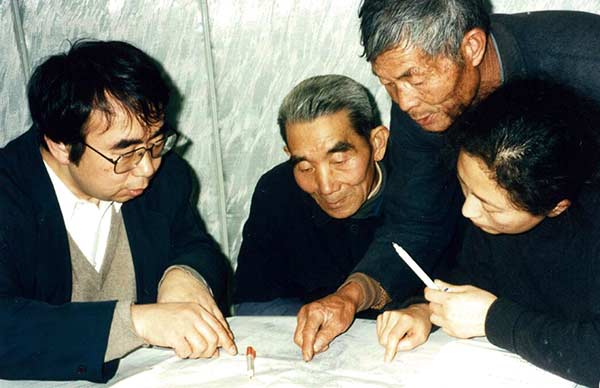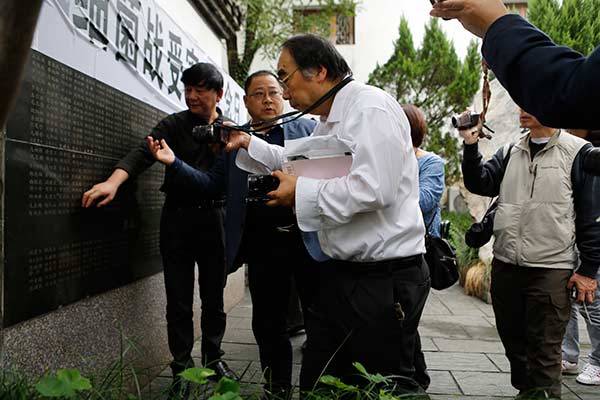
With Wang Xuan (right) as his interpreter, Keiichiro Ichinose (left) collects testimony from victims of germ warfare in Zhejiang province. Photo provided by ICHINOSE
'Doubt and distrust'
For Keiichiro Ichinose, a Japanese lawyer, "doubt and distrust" were the emotions he read in the eyes of the people who surrounded him during his first visit to Chongshan, a village in Zhejiang province, in 1997.
"In the early 1940s, the Japanese launched large-scale germ warfare in many parts of the provinces of Jiangxi and Zhejiang. Chongshan lost one-third of its population-about 400 people-to bubonic plague after the bacteria was spread by the Japanese," he said. "The stories are painfully similar: people suddenly developed a high fever, struggled for hours or days, died miserably and then were buried, often hastily and secretly. Behind every tightly closed door was a suffering, helpless soul. The whole picture was hellish."
As a teenager six decades ago, Ichinose listened to the stories recounted by his father, a Japanese army conscript who fought in China between 1942 and 1945. "He wanted me to know 'the most impressive' part of his life. And he did so while we were in the bath," he said.
Ichinose has visited China nearly 100 times since 1995, to gather evidence and collect testimonies for court cases in which victims and their families sued the Japanese government for compensation for the use of germ warfare and indiscriminate bombing during the invasion of China.
Wang Xuan, a Chinese researcher and activist whose involvement in the lawsuits spans several decades, has stood beside Ichinose in court and in Chongshan. As a fluent speaker of Japanese she has translated for him during his meetings with victims.
"I have to say that at the beginning, Ichinose, like many of the Japanese lawyers who came to China to meet plaintiffs, was completely unaware of the mental impact his very presence had on the villagers. They (the Japanese) were just not always sensitive to the fact that they were 'the descendants of the invaders'," Wang said, making quote marks in the air.
"Consequently, they sometimes exuded a sense of self-righteousness, coupled with the air of men who belonged to the highly educated social elite. All this was daunting for their interviewees; poor, bitter and illiterate, and victimized by the war all their lives," she added. "A lot of communication and explanation was required before the layers of memory could be peeled away to reveal in detail what had happened more than seven decades ago."

Wang, who often slept on the desk in Ichinose's office while in Japan for court hearings, applauded her friend's perseverance: "He is thorough and tireless in research, and as a lawyer, he has set an example for Chinese academics who, regretfully, have never fully analyzed all the wartime records available to them."
According to Wang, about 5,000 Japanese people are actively engaged in unearthing their country's wartime history and seeking redress for victims across Asia. "They include lawyers, academics, journalists and teachers. Almost all of them are doing it free of charge," she said. "Their commitment goaded me forward."
As head of the plaintiffs' group between 1997 and 2007, Wang was at the center of a compensation case that went all the way from a Tokyo district court to Japan's Supreme Court. At its largest, the lawyers' group for the plaintiffs numbered 224, all of them Japanese, with Ichinose as a core member. The group was led by Khoken Tsuchiya, a one-time chairman of the Japanese Bar Association.


















































